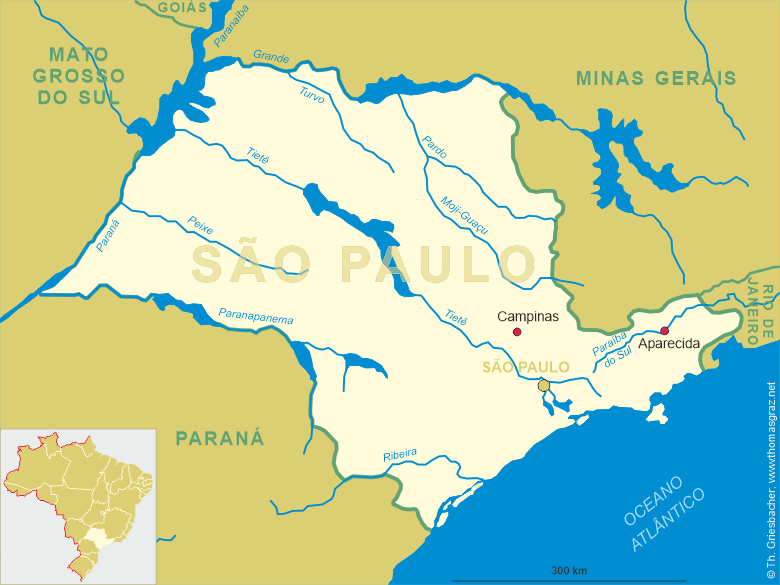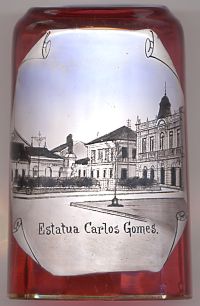| BRASIL
| BRAZIL
|
| estado: São Paulo
|
|
map →

Campinas
• lv: Kampinasa
• lt: Kampinasas
• bg, mk, ru, sr: Кампинас
• be, uk: Кампінас

 Campinas is situated at an elevation of 661 m in the state of São Paulo.
The city and county has a population of about 969,000 and is also the administrative centre of
the meso-region of the same name. Campinas is the third-largest city in the state,
after São Paulo (about 10,900,000) and Guarulhos (about 1,160,000).
Campinas is situated at an elevation of 661 m in the state of São Paulo.
The city and county has a population of about 969,000 and is also the administrative centre of
the meso-region of the same name. Campinas is the third-largest city in the state,
after São Paulo (about 10,900,000) and Guarulhos (about 1,160,000).
The city was founded on July 14, 1774. It was initially a simple outpost on the way to Minas Gerais and Goiás serving the "Bandeirantes" who
were in search of precious minerals and Indian slaves. In the first half of the 19th century, Campinas became a growing population center,
with many coffee and sugarcane farms. The construction of a railway linking it to the city of São Paulo and Santos' seaport, in 1817,
was very important for its growth. In the second half of the 19th century, with the abolition of slavery, farming and industrialisation attracted
many foreign immigrants to replace the lost manpower, mainly from Italy. Coffee became an important export and the city became wealthy. In
consequence, a large service sector was established to serve the growing population, and in the first decades of the 20th century, Campinas
could already boast as having an opera house, theaters, banks, movie theaters, radio stations, a philarmonic band, two newspapers, a good public
education system, hospitals and the most important Brazilian research center in agricultural sciences, the Instituto Agronômico de Campinas,
which was founded by Emperor Pedro II. Finally, the construction of the first Brazilian highway in 1938, between Campinas and São Paulo,
the Anhanguera Highway, was a turning point in the integration of Campinas into the rest of the state.
[Text adapted from http://en.wikipedia.org/wiki/Campinas]
The picture on glass no. 2291 [left] shows the  statue of Carlos Gomes.
Antônio Carlos Gomes (1836–1896) was one of the most distinguished nineteenth century classical composers, being the first New World
composer whose work was accepted by Europe. He was born on 11 July, 1836, in the village of São Carlos, which is now part of the city of Campinas.
His operatic works include A Noite Do Castelo (1861), Joana De Flandres (1863) and O Guarani, which premiered in
1870 Milan's La Scala Theatre as Il Guarany. The success was enormous. Even the most strict musical critics compared the Brazilian
musician to the great European maestros, such as Rossini and Verdi. The King of Italy, Vittorio Emmanuele II, decorated the creator of the opera,
which was presented in all major European capitals. Before that year was over, Gomes returned to Brazil where he organized the premiere of Il Guarany in
Rio de Janeiro. The piece achieved the same success Gomes had seen in Italy. After having returned to Italy he wrote the hymn Il saluto del Brasile
for the centenary of American independence which was performed in Philadelphia, on July 19, 1876.
The opera Lo Schiavo debuted in 1889. When the Brazilian republic was proclaimed, Carlos Gomes, who at this time was in Campinas, sailed once
more to Italy. Faithful to the monarchy and Dom Pedro II, Gomes refused the opportunity given to him by president Deodoro da Fonseca to compose
the Brazilian National Anthem. In the following years, he composed the opera Condor and the cantata Colombo, for the Columbus Festival
(1892), in celebration of the forth centenary of the discovery of America. Carlos Gomes died on September 16, 1896, in Belém.
In 1905 his mortal remains were transfered from the capital of the state of Pará to Campinas. His tomb, located in Praça Bento Quirino,
was ornated by a granite pedestal surmounted by a bronze statue of the maestro in the pose of chef d'orchestre.
statue of Carlos Gomes.
Antônio Carlos Gomes (1836–1896) was one of the most distinguished nineteenth century classical composers, being the first New World
composer whose work was accepted by Europe. He was born on 11 July, 1836, in the village of São Carlos, which is now part of the city of Campinas.
His operatic works include A Noite Do Castelo (1861), Joana De Flandres (1863) and O Guarani, which premiered in
1870 Milan's La Scala Theatre as Il Guarany. The success was enormous. Even the most strict musical critics compared the Brazilian
musician to the great European maestros, such as Rossini and Verdi. The King of Italy, Vittorio Emmanuele II, decorated the creator of the opera,
which was presented in all major European capitals. Before that year was over, Gomes returned to Brazil where he organized the premiere of Il Guarany in
Rio de Janeiro. The piece achieved the same success Gomes had seen in Italy. After having returned to Italy he wrote the hymn Il saluto del Brasile
for the centenary of American independence which was performed in Philadelphia, on July 19, 1876.
The opera Lo Schiavo debuted in 1889. When the Brazilian republic was proclaimed, Carlos Gomes, who at this time was in Campinas, sailed once
more to Italy. Faithful to the monarchy and Dom Pedro II, Gomes refused the opportunity given to him by president Deodoro da Fonseca to compose
the Brazilian National Anthem. In the following years, he composed the opera Condor and the cantata Colombo, for the Columbus Festival
(1892), in celebration of the forth centenary of the discovery of America. Carlos Gomes died on September 16, 1896, in Belém.
In 1905 his mortal remains were transfered from the capital of the state of Pará to Campinas. His tomb, located in Praça Bento Quirino,
was ornated by a granite pedestal surmounted by a bronze statue of the maestro in the pose of chef d'orchestre.
[Text adapted from http://en.wikipedia.org/wiki/Carlos_Gomes]
![[scale]](lineal.jpg)



 Campinas is situated at an elevation of 661 m in the state of São Paulo.
The city and county has a population of about 969,000 and is also the administrative centre of
the meso-region of the same name. Campinas is the third-largest city in the state,
after São Paulo (about 10,900,000) and Guarulhos (about 1,160,000).
Campinas is situated at an elevation of 661 m in the state of São Paulo.
The city and county has a population of about 969,000 and is also the administrative centre of
the meso-region of the same name. Campinas is the third-largest city in the state,
after São Paulo (about 10,900,000) and Guarulhos (about 1,160,000).
 statue
statue![[scale]](lineal.jpg)